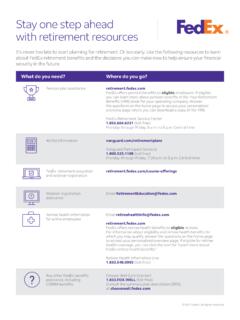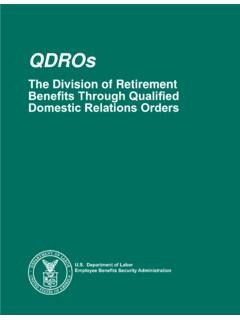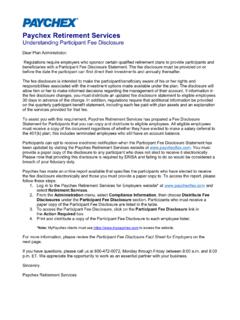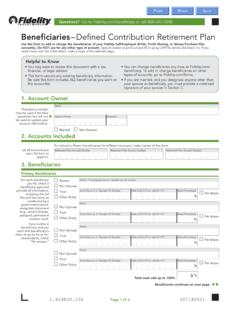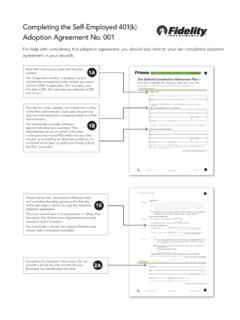Transcription of CHOOSING A RETIREMENT SOLUTION - IRS tax forms
1 CHOOSING A. RETIREMENT SOLUTION . FOR YOUR SMALL BUSINESS. CHOOSING a RETIREMENT SOLUTION for Your Small Business is a joint project of the Department of Labor's Employee Benefits Security Administration (EBSA) and the Internal Revenue Service. To view this and other EBSA publications, visit the agency's website at: To order publications or request assistance from a benefits advisor, contact EBSA electronically at: Or call toll free: 866-444-3272. This publication will be made available in alternative format to persons with disabilities upon request. Voice Phone: (202) 693-8664. TTY: (202) 501-3911. This publication constitutes a small entity compliance guide for purposes of the Small Business Regulatory Enforcement Fairness Act of 1996.
2 It does not constitute legal, accounting, or other professional advice. Starting a RETIREMENT savings plan can The amount of the credit is based on the be easier than most business owners contributions participants make and their credit rate. The maximum contribution eligible for the think. What's more, there are a number credit is $2,000. The credit rate can be as low as of RETIREMENT programs that provide 10 percent or as high as 50 percent, depending on tax advantages to both employers and the participant's adjusted gross income; and employees. q A Roth program that can be added to a 401(k) plan to allow participants to make after-tax contributions into separate accounts, providing an additional way Why Save?
3 To save for RETIREMENT . Distributions upon death or Experts estimate that Americans will need 70 to 90 disability or after age 59 1/2 from Roth accounts held percent of their preretirement income to maintain their for 5 years, including earnings, are generally tax-free. current standard of living when they stop working. So now is the time to look into RETIREMENT plan programs. As an employer, you have an important role in helping A Few RETIREMENT Facts America's workers save. Most private-sector RETIREMENT vehicles are either Individual RETIREMENT Arrangements (IRAs), defined By starting a RETIREMENT savings plan, you will help contribution plans, or defined benefit plans.
4 Your employees save for the future. RETIREMENT plans may also help you attract and retain qualified employ- People tend to think of an IRA as something that ees, and they offer tax savings to your business. You individuals establish on their own, but an employer will help secure your own RETIREMENT as well. You can can help its employees set up and fund their IRAs. establish a plan even if you are self-employed. With an IRA, the amount that an individual receives at RETIREMENT depends on the funding of the IRA and the earnings (or losses) on those funds. Any Tax Advantages? A RETIREMENT plan has significant tax advantages: Defined contribution plans are employer-established plans that do not promise a specific benefit at q Employer contributions are deductible from RETIREMENT .
5 Instead, employees or their employer (or the employer's income, both) contribute to employees' individual accounts q Employee contributions (other than Roth under the plan, sometimes at a set rate (such as 5. contributions) are not taxed until distributed to percent of salary annually). At RETIREMENT , an employee the employee, and receives the accumulated contributions plus earnings q Money in the plan grows tax-free. (or minus losses) on the invested contributions. Defined benefit plans, on the other hand, promise a Any Other Incentives? specified benefit at RETIREMENT ; for example, $1,000 a In addition to helping your business, your employees, month.
6 The amount of the benefit is often based on and yourself, it's easy to establish a RETIREMENT plan, a set percentage of pay multiplied by the number of and there are additional reasons for doing so: years the employee worked for the employer offering the plan. Employer contributions must be sufficient to q High contribution limits so you and your employees fund promised benefits. can set aside large amounts for RETIREMENT ;. q Catch-up rules that allow employees age 50 and Small businesses may choose to offer IRAs, defined over to set aside additional contributions. The contribution plans, or defined benefit plans. Many catch up amount varies, depending on the type financial institutions and RETIREMENT plan practitioners of plan; make available one or more of these RETIREMENT plans q A tax credit for small employers that enables them to that have been pre-approved by the IRS.
7 Claim a credit for part of the ordinary and necessary costs of starting a SEP, SIMPLE, or certain other On the following two pages you will find a chart outlining the types of RETIREMENT plans (more on these later). The advantages of each of the most popular types of IRA-based and credit equals 50 percent of the cost to set up and defined contribution plans and an overview of a defined benefit administer the plan, up to a maximum of $500 per plan. year for each of the first 3 years of the plan;. q A tax credit for certain low- and moderate-income individuals (including self-employed) who make contributions to their plans ( Saver's Credit ).
8 -1- IRA-BASED PLANS DEFINED CONTRIBUTION PLANS DEFINED BENEFIT. PLANS. Payroll SEP SIMPLE IRA Plan Profit Sharing Safe Harbor 401(k) Automatic Enrollment Traditional 401(k). Deduction IRA 401(k). Key Easy to set up and maintain. Easy to set up and maintain. Salary reduction plan with little Permits employer to make large Permits high level of salary deferrals Provides high level of participation and Permits high level of salary deferrals by Provides a fixed, pre-established administrative paperwork. contributions for employees. by employees without annual permits high level of salary deferrals by employees. benefit for employees.
9 Advantage nondiscrimination testing. employees. Also safe harbor relief for default investments. Employer Any employer with one or Any employer with one or Any employer with 100 or Any employer with one or more Any employer with one or more Any employer with one or more Any employer with one or more Any employer with one or more more employees. more employees. fewer employees that does employees. employees. employees. employees. employees. Eligibility not currently maintain another RETIREMENT plan. Employer's Arrange for employees to make May use IRS form 5305-SEP May use IRS form 5304-SIMPLE No model form to establish this No model form to establish this plan.
10 No model form to establish this No model form to establish this No model form to establish this plan. payroll deduction contributions. to set up the plan. No annual or 5305-SIMPLE to set up plan. May need advice from a May need advice from a financial plan. May need advice from a financial plan. May need advice from a financial Advice from a financial institution Role Transmit contributions for filing requirement for employer. the plan. No annual filing financial institution or employee institution or employee benefit institution or employee benefit adviser. institution or employee benefit adviser. or employee benefit adviser would employees to IRA.










